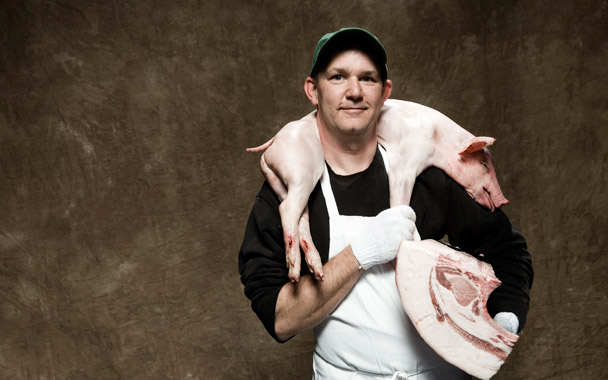When I first started out, the handling of animals was atrocious. It was non-stop electric prods,” says Temple Grandin, reflecting on the nearly four decades she has spent designing humane slaughterhouses for the meat industry. When Grandin began her work in the early 1970s, she did it from the cow’s perspective, climbing into processing chutes to identify the shadows, reflections, and bright lights that scared the animals and made them balk. Grandin, who recently published her sixth book, Animals Make Us Human, has worked with processing plants big and small and has witnessed nightmarish conditions. Today, she’s most excited about the video auditing system she created that allows independent third parties to monitor slaughterhouses at any time over the Internet: Cargill recently announced it would install the system in all of its plants. “I worked on it for an entire year,” Grandin says. “We should have it running in seven or eight beef plants by the end of the year.”
While plenty of people pay attention to the question of what it means to raise an animal humanely, far fewer stop to consider the notion—and the ostensible paradox—of humane slaughter. Words like “pastured,” “grass-fed,” and “free-range” are now synonymous with quality meat; they carry a potent if symbolic meaning that has eased many a consumer’s conscience and driven many a marketing campaign. But the idea of how an animal meets its ultimate fate is usually ignored—until, of course, we see YouTube videos of sick cows being hauled to their deaths on bulldozers.
“My perspective of what is humane is broader than how you harvest a cow. It’s how we treat humans, too,” says Bev Eggleston, the founder of EcoFriendly Foods. Eggleston processes animals in the small, multi-species plant he built in rural Virginia almost ten years ago, inspired in part by Grandin’s methods. Though his sustainable meat and poultry have attained a cult-like following among chefs and home cooks alike, the reality of producing it is far from glamorous.
Because of his plant’s small size (it employs 15 laborers), his unwavering conviction that “the animal needs to be respected,” and his concern for his workers’ welfare, Eggleston’s operation is an expensive and relatively inefficient one. Whereas the conventional meat industry (which he refers to as “my competition”) may process 130 chickens a minute, Eggleston and his workers process about 400 a day, “the least you can do and still afford to turn on the equipment and pay everyone.” Last year, he says, they were doing about 800 a day, but the workers were exhausted after lunch. “Humane treatment of labor is an economic concern,” he says. To treat animals fairly, he needs to treat his workers fairly. “You have to consider the human aspects of what it takes to do this job. My laborers are just trying to get a paycheck,” Eggleston admits, “but they know I’m asking them to be compassionate and sensitive.”
Dan Barber is one of the chefs who benefits from small processors like Eggleston: Barber has served EcoFriendly meats at both of his Blue Hill restaurants. For him, the importance of humane slaughter manifests itself in the quality of the meat—but finding slaughterhouses that adhere to his standards is relatively difficult. While there is a facility for small animals like chickens and turkeys at Stone Barns, its larger animals have to go elsewhere, usually to abbatoirs in New Jersey or the Upper Hudson Valley. It’s hard to make demands on the small farmers who supply other meat to his restaurants, Barber says, because local, high-quality slaughterhouses have all but disappeared in the Hudson Valley. “Meatpackers are really interesting in having one-size-fits-all,” he says. He sees some promise in roving slaughterhouses, which visit farms and slaughter animals on site. “It’s really efficient and low-cost,” Barber says. “And the animals are less stressed because they’re processed on the farm.”
Small slaughterhouses don’t necessarily guarantee humane slaughter, however. “Line speed isn’t bad, per se,” says Grandin. “What’s bad is an understaffed and overloaded plant. I saw one small plant that was perfect with 26 cattle an hour and horrible with 35.” Poor conditions, she says, are often the result of poor management. Much of her work has focused on designing better equipment, but without proper care and operation, machines like the bolt-stunners used to kill cattle won’t ensure a swift, painless death. Again, this is where the “human” factor is so crucial to the “humane” equation: While the majority of stunner operators operate the equipment properly, Grandin says there are also sadists who need to be prevented from having any contact with animals, or the machinery that kills them.
Ultimately, for Grandin, “humane” is a loaded word. “I’d rather say low-stress, painless slaughter,” she says—ideally as stressful as a vaccination shot. The biggest obstacle, she feels, is quantity. “Quality and quantity are two opposing goals,” Grandin says. “But there’s a sensible balance.”

